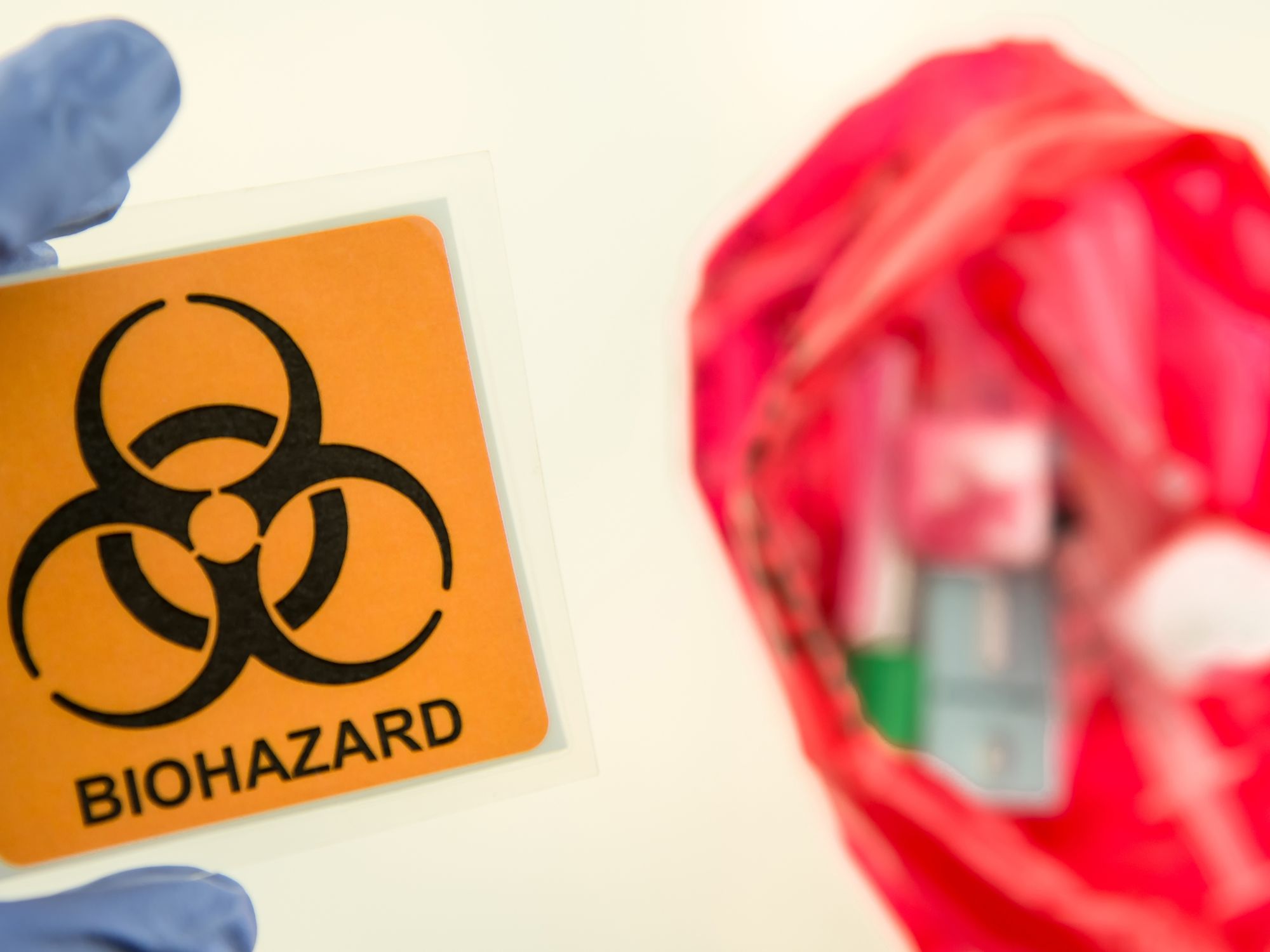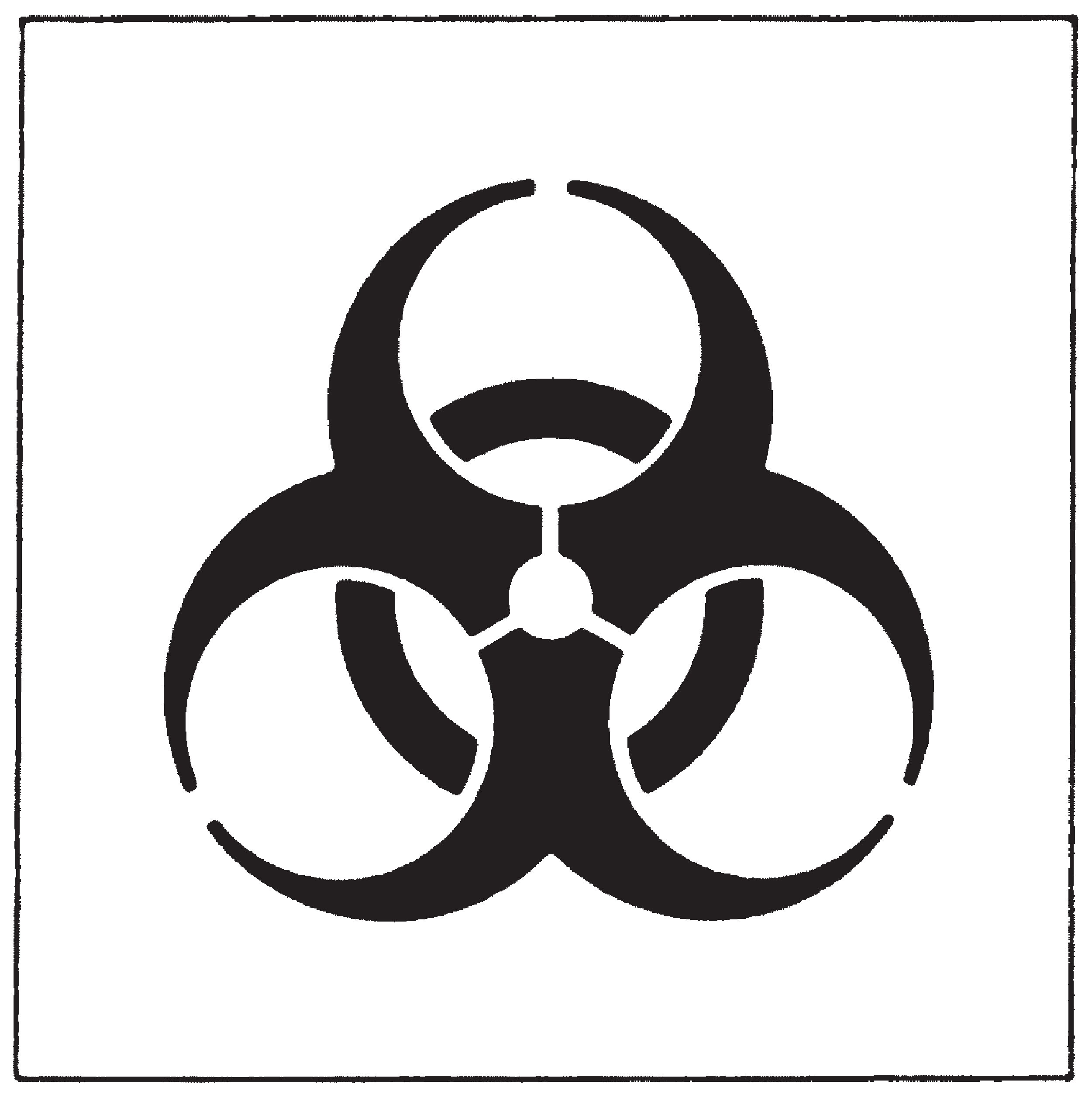Labels, tags, signs, and colors

- Employees must receive sufficient warning through labels, signs, and training to eliminate or minimize their exposure to bloodborne pathogens.
- Labels must be fluorescent orange or orange-red, with lettering and symbols in a contrasting color. However, red bags and containers can be used instead of labels.
- Biohazard markings are regulated not only at 1910.1030 but also at 1910.145.
Employees must receive sufficient visual warning to eliminate or minimize their exposure to bloodborne pathogens. When employees aren’t routinely required to deal with blood or other potentially infectious materials (OPIM), they can easily become complacent about the hazards. Employers must provide appropriate signs, tags, labels, and color-coded containers to clearly mark biohazards, and make sure that employees are thoroughly trained in recognizing, using, and complying with them.
Biohazard warning signs, labels, tags, and color-coding signify the actual or potential presence of a biohazard. They’re used to identify equipment, containers, or work areas that contain, or are contaminated with, blood or OPIM.
In general industry, the Occupational Safety and Health Administration (OSHA) regulates biohazard markings not only at 1910.1030 but also at 1910.145. Employers should review and follow the marking requirements for both regulations. Note that for the shipyard industry, 1915.1030 says its requirements are identical to 1910.1030. Likewise, 1915.91 says its requirements are identical to 1910.145. The construction industry, on the other hand, has its own signs and tags provisions at 1926.200.
When labels are required
If 1910.1030 applies, then labels must be provided on the following:
- Containers of regulated waste;
- Containers of contaminated sharps;
- Refrigerators and freezers that are used to store blood or OPIM;
- Containers used to store, transport, or ship blood or OPIM;
- Contaminated equipment that is being shipped or serviced; and
- Bags or containers of contaminated laundry, except as provided in 1910.1030.
The label must:
- Be fluorescent orange or orange-red in color or predominantly so, with lettering and symbols in a contrasting color;
- Have a legend with the biohazard symbol (see “Symbols” below) followed by the word “BIOHAZARD”; and
- Be attached with string, wire, adhesive, or another method to prevent loss or unintentional removal.
As an alternative to a label, red bags or red containers can be used.
For contaminated equipment being serviced or shipped, the label must state which parts of the equipment are contaminated. This requirement alerts employees to possible exposure, since the nature of the material or contents will not always be readily identifiable as blood or OPIM.
The labeling requirements do not preempt either the U.S. Postal Service labeling requirements (39 CFR and 18 U.S. Code Section 1691 to 1738) or the Department of Transportation’s (DOT) Hazardous Materials Regulations (49 CFR 171 to 180).
DOT labeling is required on transport containers that contain “known infectious substances.” It is not required on all containers for which 1910.1030 requires the biohazard label. Where there is an overlap between the OSHA-mandated label and the DOT-required label, the DOT label will be considered acceptable on the outside of the transport container, provided that the OSHA-mandated label (or red color-coding) appears on any internal containers that are present.
Containers serving as collection receptacles within a facility are not covered by the DOT requirements, so these must have the OSHA label.
When labels are not required
Biohazard labels are not required:
- When red bags or red containers are used instead;
- On individual containers of blood, blood components, or blood products that:
- Are clearly marked as specified by the Food and Drug Administration (FDA),
- Have been screened for hepatitis B virus (HBV) and human immunodeficiency virus (HIV), and
- Have been released for transfusion or other clinical use;
- On individual containers of blood or OPIM that are placed in a labeled container (e.g., a test tube rack) during storage, transport, shipment, or disposal; and
- On regulated waste that has been decontaminated by incineration, autoclaving, or chemical means prior to disposal.
If universal precautions are used for handling all soiled laundry, the employer may use an alternative color/label for containers, as long as all employees are trained to recognize them.
Tags
Biohazard tags made of card, paper, pasteboard, plastic, or other material are affixed as close as safely possible to a biohazard by string, wire, or adhesive that prevents the tags’ loss or unintentional removal. Biohazard tags are intended to:
- Identify the actual or potential presence of a biological hazard;
- Identify equipment, containers, or experimental animals that contain or are contaminated with hazardous biological agents; and
- Communicate biohazards that are out of the ordinary, unexpected, or not readily apparent.
Paragraph 1910.145(f) explains that the tag must use a signal word, DANGER,” “CAUTION,” “BIOHAZARD,” “Biological Hazard,” or the biological hazard symbol itself, shown in the regulation. The OSHA-recommended color scheme is fluorescent orange or orange-red, or predominantly so, with lettering or symbols in a contrasting color.
Tags need not be used where signs are posted to communicate a biohazard.
For construction, paragraph 1926.200(h) and (i) offer both: (a) modern “DANGER,” “WARNING,” or “CAUTION” tag options and color schemes; and (b) old “DANGER,” “CAUTION,” or “BIOHAZARD” tag options and color schemes. The old BIOHAZARD tag is white with a fluorescent-orange or orange-red panel with black letters. The biohazard symbol is fluorescent-orange or orange-red against the white background.
Signs
In HIV and HBV research laboratories and production facilities, signs must be posted at all access doors when OPIM or infected animals are present in the work area or containment module. According to 1910.1030, these signs must be fluorescent orange-red or predominantly so, with lettering and symbols in a contrasting color. They must also contain the following information: the name of the infectious agent, special requirements for entering the area, and the name and telephone number of the laboratory director or other responsible person.
Other general industry and shipyard workplaces should follow 1910.145 for biological hazard signs, which have a biological hazard warning to signify the actual or potential presence of a biohazard and to identify things that contain, or are contaminated with, viable hazardous agents. Section 1910.145 doesn’t specify the text, symbol, color, or format of biological hazard signs, giving the employer flexibility.
For construction, 1926.200 calls for employers to follow either: (a) modern “DANGER,” “WARNING,” “CAUTION,” or “SAFETY INSTRUCTION” sign options and color schemes; or (b) old “DANGER,” “CAUTION,” “SAFETY INSTRUCTION,” or “BIOHAZARD” sign options and color schemes. The old BIOHAZARD sign does not have a color scheme for the signal word or message but does call for a biohazard symbol that is fluorescent orange or orange-red on contrasting background.
Symbols
Below is the universal biohazard symbol legend as it appears in 1910.1030, as well as a diagram of the symbol that appeared in 1910.145 in the Federal Register on June 27, 1974 (on page 23680), complete with dimensions:

According to 1910.145, the symbol design for biological hazard tags must conform to the design below:

